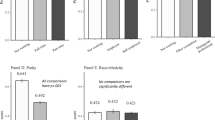Abstract
Using a sample of Toronto women, we reexamine the relationship between employment and fertility with the aim of clarifying whether employment status is negatively related to the birth rate only among certain categories of women as defined by sex roles. Especially noteworthy is the finding that employed wives who rate their performance as a spouse and mother as “better than most” have a birth rate which is as high as that for women who are not in the labor force.
Similar content being viewed by others
References
Andrews, F., Morgan, J., & Sonquist, J. Multiple classification analysis: A report on a computer program for multiple regression using categorical predictors. Ann Arbor: Institute for Social Research, University of Michigan, 1967.
Blake, J. Demographic science and the redirection of population policy. In T. R. Ford & G. De Jong (Eds.), Social demography. Englewood Cliffs, N.J.: Prentice-Hall, 1970. Pp. 326–347.
Boyd, M., Eichler, M., & Hofley, J. Family: Functions, formation and fertility. In G. Cook (Ed.), Opportunity for choice. Ottawa: Statistics Canada, in association with C. D. Howe Research Institute, 1976. Pp. 13–52.
Clarkson, F. E., Vogel, S. R., Broverman, I. K., & Broverman, D. M. Family size and sex role stereotypes. Science, 1970, 23, 390–392.
Clifford, W. B., & Tobin, P. L. Labor force participation of working mothers and family formation: Some further evidence. Demography, 1977, 14, 273–284.
Collishaw, N. Fertility in Canada 1971. Census of Canada Vol. 5, Part 1). Ottawa: Statistics Canada, 1976.
Colver, O. A. Women's work participation and fertility in metropolitan areas. Demography, 1968, 5, 55–60.
Freedman, R., Whelpton, P. K., & Campbell, A. A. Family planning, sterility and population growth. Toronto: McGraw-Hill, 1959.
Gendell, M., Maraviglia, M. N., & Kreitner, P. C. Fertility and economic activity of women in Guatemala City, 1964. Demography, 1970, 7, 273–286.
Gibbons, J. Psychological factors in ovarian and uterine dysfunction. In H. Gardiner-Hill (Ed.), Modern trends in endocrinology: Second series. New York: Paul B. Hoeber, 1961. Pp. 201–212.
Groat, H. J., Workman, R. L., & Neal, A. G. Labor force participation and family formation: A study of working mothers. Demography, 1976, 13, 115–125.
Hass, P. A. Maternal role incompatibility and fertility in urban Latin America. Journal of Social Issues, 1972, 28, 111–127.
Heer, D. Husband and wife perception of family power structure. Marriage and Family Living, 1962, 24, 65–67.
Henripin, J. Trends and factors of fertility in Canada. Ottawa: Statistics Canada, 1972.
Hoffman, L. W. The employment of women, education and fertility. Merrill-Palmer Quarterly, 1974, 20, 99–119.
Jaffe, A. J., & Azumi, K. The birth rate and cottage industries in underdeveloped countries. Economic Development and Cultural Change, 1960–1961, 9, 52–63.
Kasarda, J. D. Economic structure and fertility: A comparative analysis. Demography, 1971, 8, 307–317.
Kupinsky, S. Non-familial activity and socio-economic differentials in fertility. Demography, 1971, 8, 353–367.
Mott, F. L. Fertility, life cycle stage and female labour force participation in Rhode Island: A retrospective overrun. Demography, 1972, 9, 173–185.
Presser, H. The timing of the first birth, female roles and black fertility. Milbank Memorial Fund Quarterly, 1971, 49, 329–362.
Reed, F. W., & Udry, J. R. Female work, fertility and contraceptive use in a biracial sample. Journal of Marriage and Family, 1973, 35, 597–602.
Ridley, J. C. The changing position of American women: Education, labor force participation and fertility. Pp. 199–250 In The Family in Transition: Fogarty International Centre Proceedings (No. 3, November 3–6). Bethesda, Md.: National Institutes of Health, 1969.
Ryder, H., & Westoff, C. Reproduction in the United States: 1965. Princeton: Princeton University Press, 1965.
Safilios-Rothschild, C. Sociopsychological factors affecting fertility in urban Greece: A preliminary report. Journal of Marriage and the Family, 1969, 31, 595–607.
Scanzoni, J. Sex roles, life styles, and childbearing: Changing patterns in marriage and the family. New York: Free Press, 1975.
Sear, A. M. Predictors of contraceptive practice for low-income women in Cali, Colombia. Journal of Biosocial Behavior, 1975, 7, 171–188.
Stycos, J. M., & Weller, R. H. Female working roles and fertility. Demography, 1967, 4, 210–217.
Terry, G. Rival explainations in the work-fertility relationship. Population Studies, 1975, 29, 191–205.
Tobin, P. L. Conjugal role definitions, value of children and contraceptive practice. Sociological Quarterly, 1976, 17, 314–322.
Turk, J., & Bell, H. Measuring power in families. Journal of Marriage and the Family, 1972, 34, 215–222.
Waite, L. J., & Stolzenberg, R. M. Intended childbearing and labor force participation of young women: Insights fron nonrecursive models. American Sociological Review, 1976, 41, 235–252.
Welch, S., & Booth, A. The effect of employment on the health of married women with children. Sex Roles, 1977, 3, 385–397.
Weller, R. H. The employment of wives, dominance and fertility. Journal of Marriage and the Family, 1968, 30, 437–442. (a)
Weller, R. H. The employment of wives, role incompatibility and fertility. Milbank Memorial Fund Quarterly, 1968, 46, 507–526. (b)
Weller, R. H. The impact of employment on fertility. In A. Michel (Ed.), Family issues of employed women in Europe and America. Leiden: E. J. Brill, 1971. Pp. 154–166.
Whelpton, P. K., Campbell, A. A., & Patterson, J. E. Fertility and Family Planning in the United States. Princeton: Princeton University Press, 1966.
Zarate, A. O. Differential fertility in Monterrey, Mexico. Milbank Memorial Fund Quarterly, 1967, 45, 93–108.
Author information
Authors and Affiliations
Additional information
The authors are indebted to David Johnson, Susan Welch, and Lynn White of the University of Nebraska, and Gordon Irving of Carleton University for their comments on an earlier version of this article. The views expressed here are the authors' and not those of the Ministry of State for Urban Affairs, Government of Canada, which provided funds to conduct the study of urban crowding from which the data reported here were drawn.
Rights and permissions
About this article
Cite this article
Booth, A., Duvall, D. Sex roles and the link between fertility and employment. Sex Roles 7, 847–856 (1981). https://doi.org/10.1007/BF00287769
Issue Date:
DOI: https://doi.org/10.1007/BF00287769




